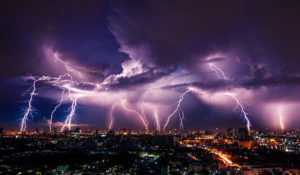June 20, 2017 | Black & Kletz Allergy

In Melbourne, Australia, on Monday, November 21, 2016, hospitals were swamped with emergency patients affected by severe asthma exacerbations. There were more than 8,500 patients from Monday night to Tuesday and 9 of them died. Firefighters and police were called in to help physicians and paramedics respond to thousands of calls after the outside conditions caused breathing problems for its many citizens. It caused many individuals, including those with a history of hay fever (i.e., allergic rhinitis), without a prior history of asthma, to experience breathing difficulties. Many had severe and/or near-fatal asthma exacerbations. The epidemic in Melbourne was due to a very unusual weather occurrence. There were thunderstorms with high wind velocities and torrential rain combined with a high pollen count sending a large amount of grass pollen allergens into the air across the city.
In normal circumstances, pollen grains penetrate into the upper airways of individuals but only reach these larger airways in the lungs due to their large size. However, it is postulated that during thunderstorms, pollen grains can rupture due to osmotic shock and release their content into the atmosphere. As a result, the very small granules released into the air are now able to reach the lower smaller airways which then in turn induce asthma symptoms.
During the first 20 to 30 minutes of a thunderstorm, a high concentration of allergenic material released by the pollen is dispersed into the atmosphere. People who have been previously sensitized to the pollen can experience acute and severe flare-ups of coughing, wheezing, chest tightness, and/or shortness of breath after inhaling these allergens. This situation described above constitutes a major concern nowadays because of the ‘‘highly likely’’ increase in the frequency of heavy precipitation events, including thunderstorms, projected by climate change scenarios for future decades.
Ironically, rainfall is usually known to remove pollens from the air. During a thunderstorm, however, dry updrafts force whole pollens into the high humidity at the cloud level, where pollens can rupture and cold downdrafts can carry pollen fragments to the ground level. The relationship between allergen exposure, airway inflammation, and clinical symptoms is complex. Factors other than allergens such as cold air and perhaps electrical charges of the atmosphere may also be playing a role in triggering asthma.
It is important to realize that people who previously had only hay fever symptoms are also at a higher risk for asthma during a thunderstorm. Patients affected by pollen allergies should be aware of the danger of being outdoors during a thunderstorm in the pollen seasons. Staying indoors with the windows closed significantly reduces the risk of asthma exacerbations. Using inhaled asthma medications (e.g., bronchodilators, corticosteroids) at the onset of symptoms can minimize the severity of the asthma “attacks.” Allergy shots (i.e., allergy immunotherapy, allergy injections) can also minimize or prevent asthma exacerbations caused by pollens, as well as dust mites, molds, pets, and cockroaches.
The board certified allergists at Black & Kletz Allergy located in the Washington, DC, Northern Virginia, and Maryland metropolitan area will readily answer any questions you have regarding your asthma and/or allergy symptoms. We have 3 offices with locations in Washington, DC, McLean, VA (Tysons Corner, VA), and Manassas, VA. All of our offices offer on-site parking. In addition, the Washington, DC and McLean, VA offices are accessible by Metro. There is also a free shuttle that runs between the McLean, VA office and the Spring Hill metro station on the silver line. Please make an appointment by calling any one of our 3 offices, or alternatively, you can click Request an Appointment and we will answer you within 24 hours by the next business day. Black & Kletz Allergy diagnoses and treats both adults and children and we are proud to serve the Washington, DC metro area residents for which we have done for more than 50 years.












